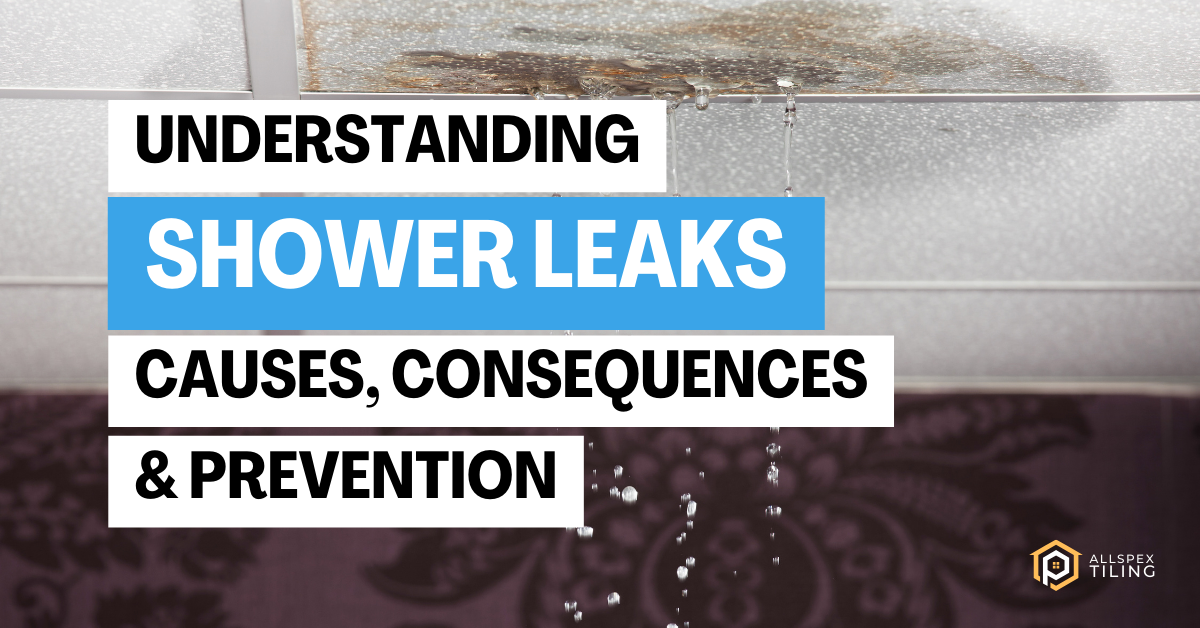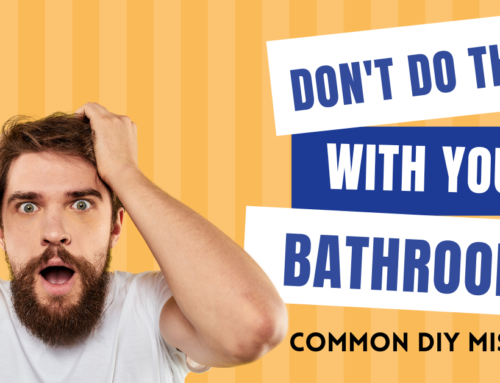If you’re like most homeowners, the sight of a water leak in your shower might trigger a mix of frustration and denial. “It’s just a small crack,” you might think. But in our world of tiles and grout, these little signs can spell big trouble. Let us walk you through what we’ve learnt from three generations of tiling – the good, the bad, and the soggy.
If you have a leaky shower, we will ask you if you know the source of the leak, that makes it easier to determine the course of action.
COMMON CAUSES OF SHOWER LEAKS
- Failure of Waterproofing: During installation, if the waterproof membrane beneath the tiles is not applied correctly or gets damaged, it can allow water to seep through the tiles and into the substrate, leading to leaks. Waterproofing needs to be seamless and cannot be broken. We cannot stress this enough. If a repairman cuts it or drills through it, it’s done.
- Cracked or Damaged Tiles and Grout: Over time, tiles and grout can crack or become damaged due to movement in the house, impact from dropped objects, or natural wear and tear. Cracks in tiles or grout lines become direct pathways for water to leak through.
- Degraded Grout: Grout, particularly traditional cement grout, is porous, and without proper sealing, it can absorb water. Over time, grout may also shrink, crack, or erode, especially in the high-moisture environment of a shower. This degradation can lead to water escaping through the grout lines and causing leaks.
- Building Movement: Houses naturally settle and shift over time, which can lead to gaps forming between tiles or between the shower unit and the walls. These gaps can be entry points for water to start leaking.
- Failed Seals Around Fixtures: The sealant used around shower fixtures, screens, and where the walls meet the floor or shower tray can deteriorate over time. When these seals fail, they allow water to escape.
- Substandard Tile Installation: Finally, if the tiles were not installed correctly—such as not allowing for adequate expansion gaps, using the wrong type of adhesive, or not ensuring a level substrate—this can lead to problems down the line, including leaks.
- Linear Drains: Linear drains look great, but we;ve seen them to be a cause of many leaks. They need careful installation. If not done right, water might leak out. Making sure they’re properly installed and sealed keeps your shower leak-free.
- Shower Hobs: The base of your shower under the shower screen, the hob, needs a good seal, especially around glass connections. It is often a culprit of leaks, so a solid seal here is crucial to keep water where it should be.
MISTAKES HOMEOWNERS MAKE WHEN THEY NOTICE A LEAKY SHOWER
Ignoring Early Signs
That tiny crack you noticed but shrugged off? It’s the beginning of what could be a long ordeal which is an absolute nightmare for homeowners. Water, as unassuming as it might seem, is a force when it comes to finding its way into every nook and cranny. Over time, a small leak can lead to significant water accumulation beneath your tiles, undermining the structure of your home from the inside out. It’s a slow process, but the end result can be catastrophic and we’ve seen too many people coming to us much later than they should and we’ll be honest – they’re not happy at the prices at this point.
Misplaced Trust in Sealing Alone
It’s easy to be swayed by solutions that promise to seal the deal without much fuss. We’ve encountered many sealing technicians, armed with good intentions and a can-do attitude, who offer up sealing as the end-all solution to fix leaks without removing tiles. But here’s the catch: without a comprehensive understanding of what’s happening beneath the tiles—something that often requires more than just a surface-level assessment—these quick fixes can fall short. Most sealing technicians lack the tools or knowledge, like moisture meters, to do proper leak detection to truly gauge the extent of the damage. Yet, a sale is often made on the promise of a warranty that, in reality, offers little reassurance. After a year, the seal fails and the technicians are nowhere to be found.
Economic Fixes Over Proper Repairs
We know, tiling is expensive! It’s a big job and no one wants to rip up their bathroom. Opting for a regrout or a seal over the removal of tiles to address a leaky shower is understandable, we don’t blame you. Truthfully, if a regrout and seal is really all you need to protect your tiles, do it! We’re not here to upsell you something you don’t need. However if you know the leak is more than just a small hole, you’re noticing mould, drummy and cracked tiles or wet patches outside of the shower, that trapped moisture will fester and do some crazy work underneath. Sealing it and hoping it will dry up, whilst saving you dough in the moment, can see the leak spreading to floorboards and, in cases of second-story bathrooms, increasing the risk of structural collapse. We’ve seen some tenants almost falling through their second floor bathrooms because the owner didn’t address the issue. It’s a stark reminder that what starts as a measure to save money can quickly evolve into a financial and emotional burden and even a danger.
HOW TO PREVENT LEAKS IN TILES
Grout with Epoxy
Ditch traditional cement grout for our Allspex FlexiShield™ epoxy—a resin-based solution that flexes with movement so is far more durable the regular grout. It is waterproof, stain-resistant and can increase the longevity of your tiles by 10 to 15 years. It is the future of tile grouting and only a few qualified tilers have the skills to use it.
Grout Inspections
Just like you, your bathroom needs a check-up every now and then. A grout inspection every five years can save you from unexpected guests (like mould and structural damage). A tiler can notice any minor holes in the grouting, check for cracked, loose or drummy tiles, and scan the tiles for any moisture that may be trapped underneath.
Mind Your Drains and Seal Your Hob
Regular checks and good seals of your drains and the hob that holds your shower screen are key to prevention. For those hard-to-reach spots, like under the shower screen, a thorough seal is crucial. While it’s a detail easily overlooked, ensuring these areas are properly sealed can make all the difference in maintaining a dry and damage-free bathroom. Make sure you go with a seal that includes the shower screen removal and refit as a service if you have a hob.
So, there you have it. Understanding why your shower might be leaking, the mistakes people make and the problems it can cause, and how you can prevent them is crucial. We’ve seen a lot over the years—from small cracks that turned into big headaches, to simple steps that could have saved a lot of trouble and money. Remember, keeping an eye on things like your grout, drains, and especially those tricky areas around drains, screens and hobs can make a huge difference.
We’re here because we know the ins and outs of tiling and want to help you avoid the devastated looks we see on customers’ faces when they see the cost of tile removal. Whether you decide to use us for a service or are just here reading to inform yourself a little, we hope we have helped you. And if things get a bit too soggy in your bathroom or balcony, you know where to find us. Let’s keep your homes dry, beautiful, and safe, together.






